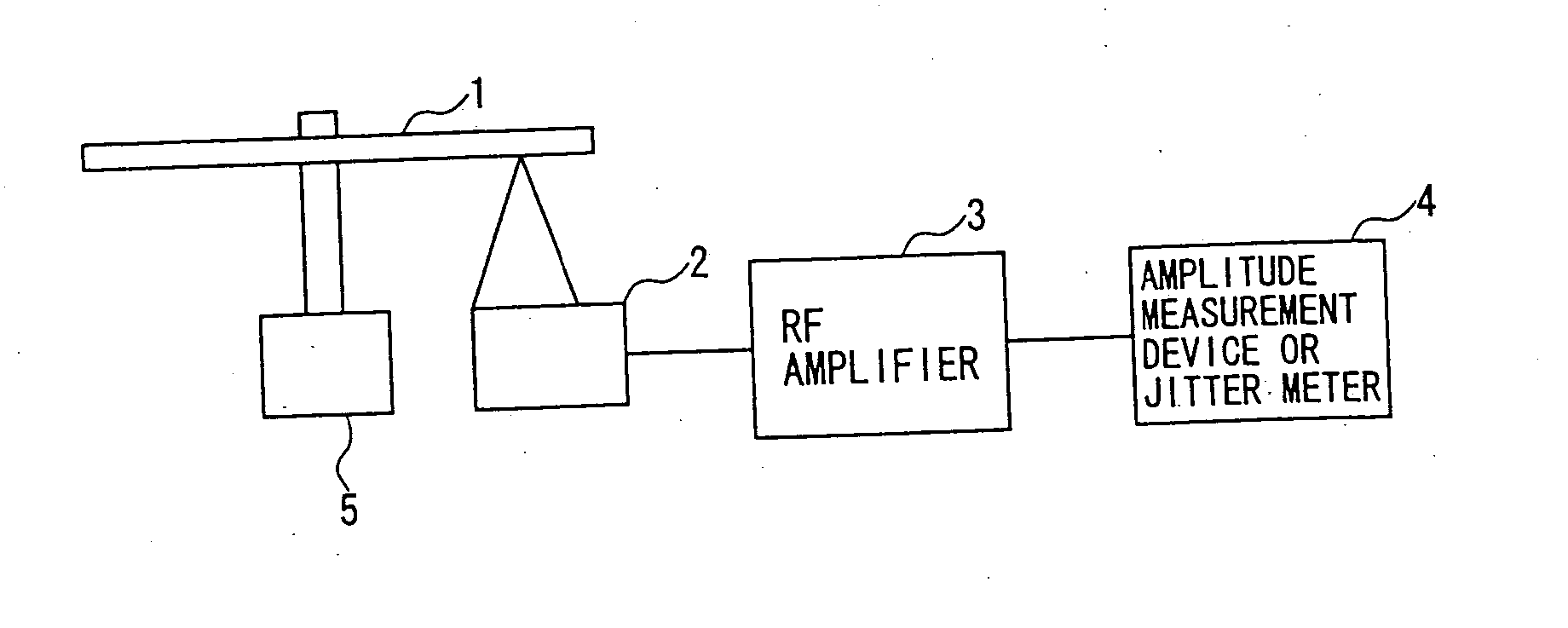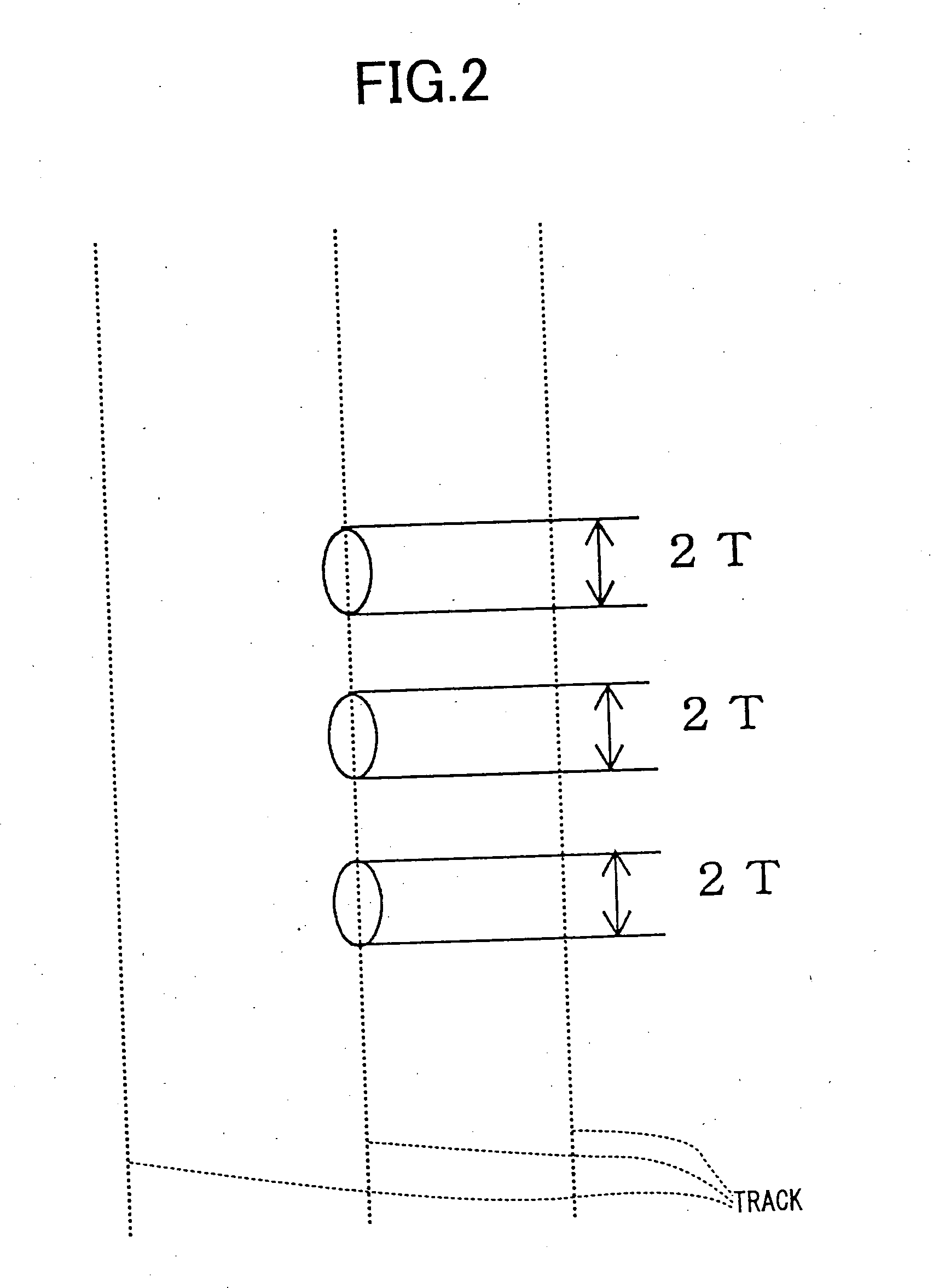Tilt detection system, tilt detection method and tilt adjustment method
- Summary
- Abstract
- Description
- Claims
- Application Information
AI Technical Summary
Benefits of technology
Problems solved by technology
Method used
Image
Examples
first embodiment
[0034]FIGS. 2 through 5 illustrate the present invention.
[0035] In the first embodiment of the present invention, a successive 2T patterns, as shown in FIG. 2, are formed at a part of the track of an ordinary CD-ROM disk for the tilt adjustment.
[0036] In the ordinary CD-ROM disks an EFM-modulated signal is recorded in a form of pits. This signal has pulse widths of 3T through 11T where T is a duration corresponding to 1 channel bit. In contrast to this, in the track of the optical disk shown in FIG. 2, in addition to the patterns corresponding to the signal recorded in the ordinary optical disk as mentioned above, the patterns each having the length corresponding to the pulse width 2T is formed which is narrower than the pulse width 3T which is the minimum one of those of the signal recorded in the ordinary optical disk.
[0037]FIG. 3A shows the eye pattern of the RF signal obtained when a reproducing operation is performed on the ordinary optical disk, and FIG. 3B shows the eye pat...
second embodiment
[0056] A second embodiment and a variant embodiment thereof of the present invention will now be described with reference to FIGS. 6, 7A, 7B, 8A and 8B.
[0057] In each of the second embodiment and variant embodiment, the tilt adjustment is performed in a condition in which the gain characteristics of a low-pass filter of an optical disk drive are changed, and, thereby, the reproduction characteristics are made severe.
[0058]FIG. 6 shows low-pass filters included in an equalizer of an RF amplifier of the optical disk drive.
[0059] The low-pass filter 11 has the gain characteristics shown in FIG. 7A such that the gain becomes the peak about the frequency corresponding to the above-mentioned 3T. In contrast to this, the low-pass filter 12 has the gain characteristics shown in FIG. 7B such that the gain decreases about the frequency corresponding to 3T.
[0060] As shown in FIG. 6, the low-pass filters 11 and 12 are connected in parallel, and one of them is selected by a change-over switch...
third embodiment
[0080] the present invention will now be described.
[0081] In each of the third embodiment and a variant embodiment thereof, the tilt adjustment is performed in a condition in which an ordinary optical disk is rotated at a rotation speed higher than the ordinary rotation speed, and, thereby, the reproduction characteristics are made severe.
[0082]FIG. 9A shows a circuit configuration of a tilt detection system in an optical disk drive in the third embodiment of the present invention.
[0083] When the rotation speed of the optical disk is increased, the resolution of the thus-obtained reproduced signal is degraded. At this time, the 3T-data pulse having the narrow pulse width is affected thereby remarkably, the reproduced amplitude decreases, and both jitter amount and error rate increase.
[0084] As a result of the reproduction condition being thus made severe, change in amplitude / jitter amount with respect to the tilt becomes steep, and, thereby, the appropriate tilt adjustment can be...
PUM
 Login to view more
Login to view more Abstract
Description
Claims
Application Information
 Login to view more
Login to view more - R&D Engineer
- R&D Manager
- IP Professional
- Industry Leading Data Capabilities
- Powerful AI technology
- Patent DNA Extraction
Browse by: Latest US Patents, China's latest patents, Technical Efficacy Thesaurus, Application Domain, Technology Topic.
© 2024 PatSnap. All rights reserved.Legal|Privacy policy|Modern Slavery Act Transparency Statement|Sitemap



